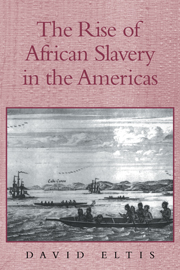Book contents
- Frontmatter
- Contents
- List of Tables
- List of Maps
- Preface
- Abbreviations
- Chapter 1 Slavery and Freedom in the Early Modern World
- Chapter 2 The English, the Dutch, and Transoceanic Migration
- Chapter 3 Europeans and African Slavery in the Americas
- Chapter 4 Gender and Slavery in the Early Modern Atlantic World
- Chapter 5 Productivity in the Slave Trade
- Chapter 6 Africa and Europe in the Early Modern Era
- Chapter 7 The African Impact on the Transatlantic Slave Trade
- Chapter 8 The English Plantation Americas in Comparative Perspective
- Chapter 9 Ethnicity in the Early Modern Atlantic World
- Chapter 10 Europe and the Atlantic Slave Systems
- Epilogue on Abolition
- Appendices
- Maps
- Sources and Bibliography
- Index
Chapter 10 - Europe and the Atlantic Slave Systems
Published online by Cambridge University Press: 05 August 2012
- Frontmatter
- Contents
- List of Tables
- List of Maps
- Preface
- Abbreviations
- Chapter 1 Slavery and Freedom in the Early Modern World
- Chapter 2 The English, the Dutch, and Transoceanic Migration
- Chapter 3 Europeans and African Slavery in the Americas
- Chapter 4 Gender and Slavery in the Early Modern Atlantic World
- Chapter 5 Productivity in the Slave Trade
- Chapter 6 Africa and Europe in the Early Modern Era
- Chapter 7 The African Impact on the Transatlantic Slave Trade
- Chapter 8 The English Plantation Americas in Comparative Perspective
- Chapter 9 Ethnicity in the Early Modern Atlantic World
- Chapter 10 Europe and the Atlantic Slave Systems
- Epilogue on Abolition
- Appendices
- Maps
- Sources and Bibliography
- Index
Summary
For nearly four centuries, two increasingly different labor systems evolved on opposite sides of the Atlantic. Chapters 1 and 2 argued that, at least as they appeared in the second half of the seventeenth century, the systems grew from the same European roots, even though interactions among peoples from all parts of the Atlantic world, especially Africa decided central issues of their geographical location and who participated in them. But the earlier chapters did not address the issue of why, in the very long run if slavery and freedom had the same origins, one survived and the other withered. It is time to return to the longer view and explore how the systems of slavery and free labor affected and sustained each other in the European-dominated Atlantic world, especially after 1700. The issue has both an economic and an ideological side.
Historians have paid most attention to the material links between European slave and non-slave sectors that straddled the Atlantic. The rapid economic growth of both slave and non-slave sectors in the European Atlantic world, especially the northwest European Atlantic world, derived ultimately from the same intra-European demographic patterns, social structures, resource mobility, market values, and market institutions that placed Europe technologically and perhaps materially ahead of the rest of the world at the outset of European expansion. Initially, capital and labor flowed to the tropical Americas from Europe, presumably because the productivity of both was higher there than in Europe.
- Type
- Chapter
- Information
- The Rise of African Slavery in the Americas , pp. 258 - 280Publisher: Cambridge University PressPrint publication year: 1999



